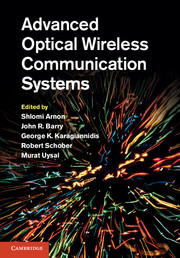Book contents
- Frontmatter
- Contents
- List of contributors
- Part I Outlook
- Part II Optical wireless communication theory
- Part III Unique channels
- 8 Modeling and characterization of ultraviolet scattering communication channels
- 9 Free-space optical communications underwater
- 10 The optical wireless channel
- 11 Hybrid RF/FSO communications
- Part IV Applications
- Index
8 - Modeling and characterization of ultraviolet scattering communication channels
from Part III - Unique channels
Published online by Cambridge University Press: 05 June 2012
- Frontmatter
- Contents
- List of contributors
- Part I Outlook
- Part II Optical wireless communication theory
- Part III Unique channels
- 8 Modeling and characterization of ultraviolet scattering communication channels
- 9 Free-space optical communications underwater
- 10 The optical wireless channel
- 11 Hybrid RF/FSO communications
- Part IV Applications
- Index
Summary
In this chapter, we examine basic modeling and characterization issues that arise from short-range communications over non-line-of-sight (NLOS) ultraviolet (UV) atmospheric scattering channels. We start by presenting the unique channel properties and history of NLOS UV communications, and introduce outdoor NLOS UV scattering link geometries. Both single and multiple scattering effects are considered, including channel impulse response and link path loss. Analysis and Monte Carlo simulation are employed to investigate the UV channel properties. We also report on experimental outdoor channel measurements, and compare with theoretical predictions.
Introduction
Why NLOS UV communications?
Within the ultraviolet (UV) spectrum 4∼400 nm, the UV-C band (sometimes called deep UV, or mid-UV) with wavelength range 200∼280 nm has unique atmospheric propagation characteristics that enable non-line-of-sight (NLOS) communications, as described in [33]. This band is essentially solar blind (e.g., see [17]), so that a ground-based photodetector can approach quantum-limited photon counting detection performance, and low-power sources can be used. At these wavelengths, scattering due to photon inter-action with atmospheric molecules and aerosols is very pronounced, and the relatively angle-independent scattering yields spatially diverse NLOS communications paths, e.g., see [21]. This rich scattering diversity enables unique NLOS optical communications, although the great majority of photons may be scattered away from the receiver and so the corresponding path loss is typically much higher than that occurring with a conventional optical LOS communication channel. The low solar background helps significantly in this regard, so that short-range links can be maintained with relatively low transmit power.
- Type
- Chapter
- Information
- Advanced Optical Wireless Communication Systems , pp. 177 - 200Publisher: Cambridge University PressPrint publication year: 2012
- 8
- Cited by



